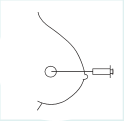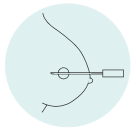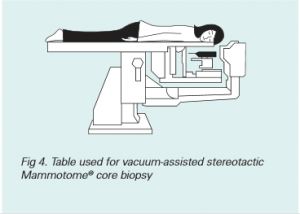[This information guide is also available in PDF for download.]
A breast biopsy is a test that removes cells or tissue from the breast so that it can be examined by a pathologist under a microscope. A biopsy gives you and your doctor important information about your breast tissue, which helps to make a diagnosis and plan treatment. In some cases, a biopsy may be used to completely remove small breast abnormalities.
There are several types of biopsy that can be used to take a sample of cells and or tissue from the breast. These biopsies include:
- Fine needle biopsy (also called fine needle aspiration biopsy, FNA or FNAB).
- Cyst aspiration for FNAB
- Core biopsy (also called core needle biopsy or CNB).
- Vacuum-assisted core biopsy (also called VACB or Mammotome®).
These procedures all differ slightly in the way they are done and in the information they can give.

Fine Needle Biopsy (FNB)
Fine needle biopsy is a quick and simple test. It removes a collection of cells from the breast with a tiny needle in much the same way as a blood sample is taken. These cells are examined by a pathologist under a microscope.
What are the advantages of fine needle biopsy.
- It is fairly simple and quick, usually taking only a few minutes.
- It can be done without any special preparation.
- The Results are available quickly.
- There is no need to stay in hospital, and no scarring of the breast as there is with surgery.
What are the limitations of the fine needle biopsy?
- The procedure may not collect enough material for a definite diagnosis.
- Sometimes, even when lots of cells are seen, the results may not be conclusive.
How is a fine needle biopsy done?
- A fine needle, smaller than a needle used for taking a blood sample, is put through the skin into the breast tissue.
- The needle stays in the breast for 20-30 seconds, gently moving through the tissue collecting cells.
- The needle is removed and pressure is applied to the breast to help stop bruising.
The procedure may need to be done several times to get enough cells. If there is a lump that is felt easily, the needle can be guided into the lump by feel. If the breast tissue that is being tested cannot be felt easily, the biopsy needle is guided accurately into the area with the help of an ultrasound or mammogram.
Is it painful ?
Most people describe a fine needle biopsy as uncomfortable but not painful. Local anesthetic (an injection to numb part of the breast) may or may not be need for this procedure.
Cyst aspiration is a procedure to remove fluid from a breast cyst. It is similar to a fine needle biopsy. Large tender cysts may be aspirated to reduce pain or small cysts may be aspirated to get a sample for testing.
Cyst fluid may or may not be sent to a pathologist to be examined under a microscope, depending on the individual circumstances. Your doctor will be able to tell you after the procedure if a sample has been sent for testing.

Cyst aspiration
Core Biopsy (also called core needle biopsy or CNB) is a test removes tiny pieces of tissue from the breast for examination by a pathologist. The test is similar to a fine needle biopsy. A specialised biopsy needle is used to take the sample. The test is always done under local anaesthetic.
What are the advantages of core biopsy?
- It is quick usually taking less than half an hour.
- It can be done without any special preparation.
- Core biopsy removes more material than fine needle biopsy and is more likely to give a definite diagnosis.
- Unlike surgery, there is no need to stay in hospital and there is minimal scarring in the breast.
What are the limitations of core biopsy?
- Core biopsy may not give a definite answer; it is not always possible to confirm or exclude cancer and more tests may be needed.
- Core biopsy takes longer to perform than fine needle biopsy.
- Side effects, such as bruising and pain are slightly more common with core biopsy than they are with fine needle biopsy (see section on side effects later in this brochure).
How is a core biopsy done?
As with fine needle biopsy, core biopsy can be done by feel or with the guidance of ultrasound or mammogram, depending on the area being sampled. Core biopsy is always done under local anaesthetic and the area being sampled is numb.
- Local anaesthetic is injected to numb the skin and breast tissue; the anaesthetic takes about 30 seconds to take effect.
- A tiny cut is made in the skin and the core biopsy needle is put in through the cut into the breast tissue.
- The biopsy uses an automatic needle that makes a loud click as a sample is taken.
- Local anaesthetic is injected to numb the skin and breast tissue; the anaesthetic takes about 30 seconds to take effect.
- A tiny cut is made in the skin and the core biopsy needle is put in through the cut into the breast tissue; the anaesthetic takes about 30 seconds to take effect.
- A tiny cut is made in the skin and the core biopsy needle is put in through the cut into the breast tissue
- he biopsy uses an automatic needle that makes a loud click as a sample is taken.
- The procedure is repeated several times (usually 3–5 times) through the same point until enough tissue has been collected.
-
Pressure is applied to the breast to help stop bruising and a dressing is put on the wound. There are no stitches needed after a core biopsy.
-
Often you will have a waterproof dressing that needs to stay in place for a few days. You will be given information about how to look after the biopsy wound before you leave the clinic.
-
You may need to take some simple pain medication such as paracetamol when the local anaesthetic wears off. An ice pack is also useful to reduce pain and bruising after a core biopsy.
Is it Painful?
Most people describe a core biopsy as uncomfortable, but not painful. The local anaesthetic is extremely effective in numbing the biopsy area. You will feel a pushing sensation as the samples are taken, but it should not be painful. If you feel pain, more anaesthetic can be used.
Vacuum-Assisted Stereotactic Core Biopsy (VACB) (Mammotome® or Vacora®)
VACB (often referred to by brand name, Mammotome ® or Vacora ®) is a specialised type of core biopsy. These procedures remove lots of small pieces of tissue from the breast. They are similar to a standard core biopsy, but use specialised needles with suction to help get the sample from the breast.
These procedures may use computer technology called stereotaxis to accurately guide the biopsy needle to the right position. This is needed in cases where an abnormal area can be seen on a mammogram but cannot be felt clinically or seen on ultrasound. This may be an area of microcalcification or a density or ‘shadow’ on a mammogram. VACB procedures can also be done under the guidance of ultrasound.
What are the advantages of VACB?
-
It removes more tissue than a fine needle biopsy or a core biopsy, increasing the chances of getting a definite result.
-
It can be used to biopsy abnormal breast tissue, (such as microcalcification), that is only visible on a mammogram, and would otherwise have to be sampled with an operation.
- It is performed under local anaesthetic, and it causes less scarring than an operation.
- There is no special preparation needed.
What are the limitations of VACB?
-
Some patients will not be found suitable for this procedure after they have been put in position on the table. This can happen for a range of unpredictable technical reasons (if this happens, your doctor will explain why, and discuss alternatives with you).
- Bruising after VACB is more common than with fine needle biopsy and core biopsy.
-
Sometimes the result is still inconclusive, or the result shows a more serious abnormality and an operation is required as well as the VACB.
-
Mammotome® may not be suitable for people who have difficulty lying in the required position, such as people who suffer from arthritis or are pregnant.
- Vacora® may not be suitable for people who faint during medical procedures.
- It usually takes an hour or more to perform the biopsy.

How is a stereotactic Mammotome® VACB done?
- You will be asked to lie face down on a padded table, placing the breast through a hole in the table.
- The breast will be compressed to hold it in place, as it is during a mammogram, but not as firmly.
- With the breast in position, a mammogram picture is taken to locate the area to be biopsied.
- Computer X-ray technology allows the doctor to see the exact position of the abnormality and to plan the best approach for the procedure.
- From beneath the table, the doctor will numb the skin of the breast with an injection of local anaesthetic.
- The needle is put into the breast and a vacuum is applied, several small samples of tissue are removed.
- You will hear a whirring noise as the vacuum is applied and the needle moves in and out of the breast removing tissue samples.
- A further mammogram picture is taken at the end of the procedure.
- An X-ray is taken of the tissue that is removed to confirm that it contains the abnormal area.
- Paper tapes and a dressing are put on the wound (stitches are not normally needed).
If the abnormal area is very small, most or all of it may be removed during a VACB procedure. If this happens, the doctor may place a tiny metal clip in the breast where the sample was taken from. This clip allows the area to be seen on future mammograms and to be found again easily if more treatment is needed.The clip can safely be left in the breast as it is very small and does not cause any irritation.
During a VACB procedure, there will be some technical discussion between the doctor and the radiographer performing the biopsy. This communication is an important part of planning an accurate biopsy of an area which cannot be felt and can only be seen on a mammogram.
How is a stereotactic Vacora® VACB done?
The procedure is similar to Mammotome® biopsy except it is done while you are sitting upright.
Is VACB painful ?
Some women find the position lying face down or sitting upright uncomfortable, and some find the compression of the breast uncomfortable. Remember, much less compression is used for the biopsy than for a mammogram. The breast is gently compressed for at least 20 minutes, and up to one hour. The injection of local anaesthetic stings a little at first, but numbs the area very quickly. You may feel a sense of pressure or pushing during the procedure; this is normal and should not be painful.
Ultrasound- guided Mammotome® or Vacora® core biopsy.
Mammotome® or Vacora® biopsies can also be done under the guidance of ultrasound rather than mammogram. These procedures are similar to stereotactic biopsy except that you will lie on your back rather than face down, and no compression or X-rays are used.
What are the side effects of breast biopsies?
Breast biopsies usually do not have complications.
Possible side effects are the same for all types of breast biopsy. How often these side effects happen and how severe they may be depends on the type of biopsy. In general, side effects are less common and are less significant with fine needle biopsy, cyst aspiration and core biopsy than they are with Mammotome® or Vacora® VACB.
Bruising and bleeding
-
A small bruise where the biopsy was done is very common; this needs no special treatment and it will disappear in a few days.
-
Rarely, a large bruise which is felt as a lump in the breast develops; this also usually needs no special treatment, but it can take up to three weeks to disappear.
- Bruising is more common with core biopsy and VACB than it is with fine needle biopsy.
It is important that you tell your doctor before the procedure if you are on any medications (such as Warfarin, aspirin, and anti-inflammatory tablets) which make you bleed or bruise more easily than normal.
Pain
- Fine needle biopsy and cyst aspiration are usually described as stinging, like having a blood sample taken
-
Core biopsy and VACB are done under local anaesthetic; the anaesthetic injection stings and then numbs the area so the rest of the procedure is not painful.
-
Everyone’s pain tolerance is different and is difficult to predict; if you have an unexpected amount of pain during the biopsy, the doctor will stop and discuss the options with you.
- After the biopsy has finished and the local anaesthetic has worn off, you may feel uncomfortable.
- Applying an ice pack on and off for the rest of the day can help to deal with any pain.
- Simple over-the-counter pain medications such as paracetamol and paracetamol/codeine combinations are usually all that is needed for pain relief.
- You should avoid using aspirin for pain as it may increase bruising.
Fainting
- If you sometimes faint during medical procedures, tell your doctor before the biopsy begins.
- If you are not feeling well after the biopsy, you will be able to lie down for as long as you need to recover.
Infection
- Infection in the breast after a biopsy is very rare.
- Antiseptic and sterile, single-use needles are used during the biopsy to reduce the chances of infection.
-
If your breast becomes red, swollen or tender in the few days after the biopsy, you should see your general practitioner (GP) or return to the clinic for the biopsy site to be checked.
Reaction to local anaesthetic
- Allergic reactions to local anaesthetic are extremely rare.
-
If you have had problems with local anaesthetic for medical or dental procedures in the past, please tell your doctor before the breast biopsy.
Collapsed lung (pneumothorax)
-
This is an extremely rare complication that occurs when the covering of the lung under the breast is damaged by the biopsy needle causing the lung to partially collapse.
-
The symptoms of pneumothorax include chest pain and shortness of breath; if you experience these symptoms in the 24 hours following a breast biopsy, you should contact one of the phone numbers below or go to the hospital Emergency Department.
-
If a pneumothorax occurs, you will need to have chest X -rays and you may need to go to hospital for observation or treatment.
Tell your doctor before procedure if you:
- Have any allergies.
- Have had a reaction to local anaesthetic in the past.
-
Have had a reaction to iodine-based antiseptics, such as Betadine® in the past because this is often used to clean the skin before the biopsy.
-
Have had any medications that make you bleed or bruise easily, such as aspirin, Warfarin, or anti-inflammatory tablets.
-
Have a heart condition requiring you to take an antibiotic dose before medical or dental procedures.
Tell your doctor before the procedure if you:
- Have any allergies
- Have had a reaction to local anaesthetic in the past
- Have had a reaction to iodine-based antiseptics, such as Betadine® in the past because this is often used to clean the skin before the biopsy
- Have had any medications that make you bleed or bruise easily, such as aspirin, Warfarin, or anti-inflammatory tablets
- Have a heart condition requiring you to take an antibiotic dose before medical or dental procedures.
Who will perform the biopsy?
The breast biopsy will be performed by a doctor. The doctor may be a radiologist, surgeon, breast physician or pathologist. A pathology scientist, radiographer, and or a nurse may also be there to help.
When will I get the results?
- You may get a preliminary result from a fine needle biopsy or cyst aspiration the same day; the final result may take several days.
- Results from a core biopsy (including VACB) take up to a week.
- Before you leave the biopsy clinic, your doctor will usually arrange a separate appointment to discuss the results with you.
General information about breast biopsies
- Bring any recent mammograms or breast ultrasound pictures with you on the day of the biopsy.
- Wear comfortable clothes; a two-piece outfit is recommended as you will need to undress from the waist up for the biopsy.
- Avoid using deodorant, perfume and talcum powder on the day of the biopsy as these can interfere with the X-ray quality.
- While you will not be drowsy after a breast biopsy, you may wish to bring someone with you for support and to drive you home.
If you have any problems after your breast biopsy, contact the Breast Centre or your GP. You may also go to the Emergency Department at your closest hospital if you are concerned at any stage or if you need treatment after hours.
Useful contacts/websites
| Cancer Australia | canceraustralia.gov.au |
| Cancer Council | cancer.org.au |
| Cancer Council Helpline | 13 11 20 |
| Breast Cancer Network Australia (BCNA) | 1800 500 258 bcna.org.au |
[This information guide is also available in PDF for download.]
Version 5 – WSP 225 May 2022
© Westmead Breast Cancer Institute 2022
